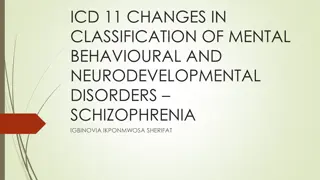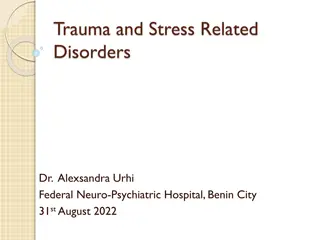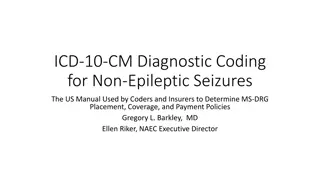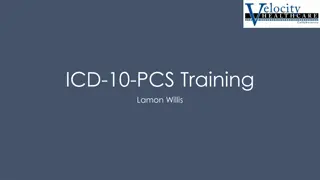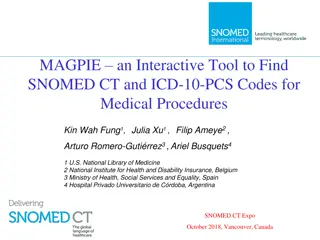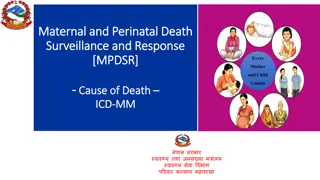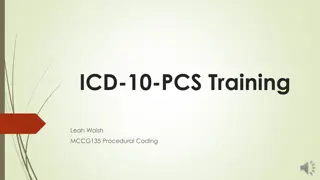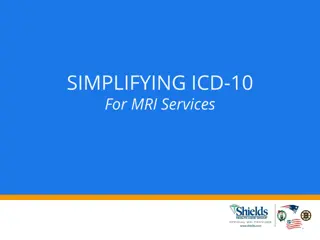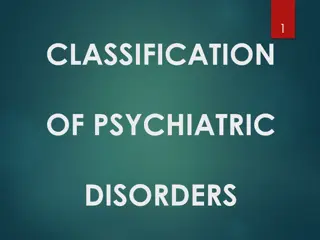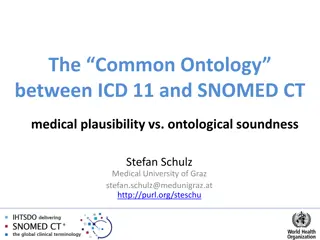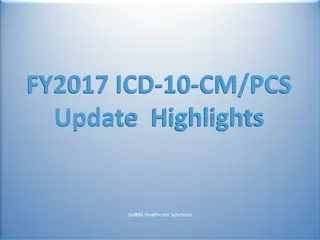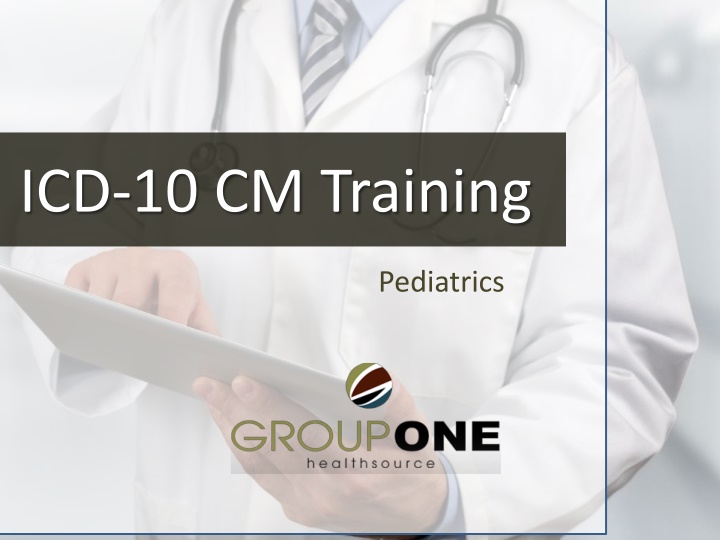
Understanding ICD-10-CM Code Structure and Guidelines
Discover key information about ICD-10-CM, including compliance dates, covered entities, code structure, placeholders, 7th character usage, laterality coding, and more. Get insights into the intricacies of pediatric ICD-10-CM training and guidelines for accurate medical coding.
Download Presentation

Please find below an Image/Link to download the presentation.
The content on the website is provided AS IS for your information and personal use only. It may not be sold, licensed, or shared on other websites without obtaining consent from the author. If you encounter any issues during the download, it is possible that the publisher has removed the file from their server.
You are allowed to download the files provided on this website for personal or commercial use, subject to the condition that they are used lawfully. All files are the property of their respective owners.
The content on the website is provided AS IS for your information and personal use only. It may not be sold, licensed, or shared on other websites without obtaining consent from the author.
E N D
Presentation Transcript
ICD-10 CM Training Pediatrics
ICD-10-CM Compliance Dates ICD-10-CM will be valid for dates of service on or after October 1, 2015 Outpatient dates of service of October 1, 2015 and beyond. Inpatient hospital service claims, is effective for dates of discharge after September 30, 2015
Covered and Non-Covered Entities Covered Entities Everyone covered by the Health Insurance Portability Accountability Act (HIPAA) Non-Covered Entities Worker s Compensation Auto Insurance Non covered HIPAA entities are exempt but are encouraged to adapt the new code set
ICD-10 Code Structure 21 Chapters Alpha-numeric codes; not case-sensitive Codes begin with Alpha letter, A-Z, excluding U Common errors I verses 1 O verses 0 x Placeholder 3 to 7 characters Decimal following 3rdcharacter
ICD-10 Code Structure Placeholder x Used for future expansion of a code Fills in empty characters when a 6thand/or 7thcharacter apply The placeholder may be used in different scenarios but should never serve as the final character. Example: W19.XXXA Unspecified fall, Initial Encounter
ICD-10 Code Structure 7thCharacter Provides specified information regarding the clinical visit Is required for certain categories and must be reported in the seventh position May be alpha or numeric Has different meanings depending on the coding category
ICD-10 Code Structure Laterality Some ICD-10-CM codes indicate laterality, specifying whether the condition occurs on the left, right or is bilateral. If no bilateral code is provided and the condition is bilateral, assign separate codes for both the left and right side. If the side is not identified in the medical record, assign the code for the unspecified side. OGCR section 1.B.13
ICD-10 Code Structure Other Codes Codes titled other or other specified are for use when the information in the medical record provides detail for which a specific code does not exist. Unspecified Codes Codes titled unspecified are for use when the information in the medical record is insufficient to assign a more specific code. OGCR section 1.A.9.a.b
ICD-10 Structure Excludes Notes Excludes1 A type 1 Excludes note is a pure excludes note It means NOT CODED HERE The code excluded should never be used at the same time When two conditions cannot occur together Excludes2 Represents Not included here The condition excluded is not part of the condition represented by the code It is acceptable to use both the code and the excluded code together, when appropriate OGCR section 1.A.12.a.b
ICD-10 Code Structure Code First and Use Additional Code ICD-10 has a coding convention that requires the underlying condition be sequenced first followed by the manifestation. These instructional notes indicate the proper sequencing order of the codes. OGCR section 1.A.13 The - indicates there are additional reporting options
ICD-9-CM to ICD-10-CM Conversion Utility (GEMs) in eCW From top tool bar Billing ICD ICD-9-CM to ICD-10-CM Conversion Utility (GEMs)
ICD-9-CM to ICD-10-CM Conversion Utility (GEMs) in eCW Type in ICD-9-CM Code Select- Map to ICD-10-CM ICD-10-CM Code will appear IF code is not a one-to-to conversion, modifier selections will appear to narrow search.
IMO/Smart Search IMO is a registered trademark for Intelligent Medical Objects. Integrates software in the practice management systems to allow for a quick search of medical terms and codes. Allows for a search using physician verbiage, partial terms or ICD codes. System integrates with eCW Smart Search is the result of IMO functionality within a practice management system. Is available at no cost Is found in the assessment section of the progress note Allows easier search of codes (ICD-9 to ICD-10)
Routine Infant or Child Health Examination ICD-9 Code ICD-10 Code Description Excludes1 Excludes2 V20.2 Z00.129 Encounter for routine child health examination without abnormal findings Encounter for routine child health examination NOS Encounter for development testing of infant or child Health check (routine) for child over 28 days old Health check for child under 29 days old (Z00.11-) Health supervision of foundlingor other health infant or child (Z76.1- Z76.2) Newborn health examination (Z00.11-) N/A V20.2 Z00.121 Encounter for routine child health examination with abnormal findings Use additional code to identify abnormal findings Health check for child under 29 days old (Z00.11-) Health supervision of foundlingor other health infant or child (Z76.1- Z76.2) Newborn health examination (Z00.11-) N/A
Well Examination Documentation Tips Identify routine health check Adult Child Newborn Under 8 days old 8-28 days old Identify presence/absence of abnormal findings With abnormal findings Without abnormal findings Use an additional code for any abnormal findings
Encounter for examination of ears and hearing ICD-9 Code ICD-10 Code Description Excludes1 Excludes2 V72.19 Z01.10 Encounter for examination of ears and hearing without abnormal findings encounter for examination for administrative purposes (Z02.-) encounter for examination for suspected conditions, proven not to exist (Z03.-) encounter for laboratory and radiologic examinations as a component of general medical examinations(Z00.0-) encounter for laboratory, radiologic and imaging examinations for sign(s) and symptom(s) - code to thesign(s) or symptom(s) N/A There are more specific code choice selections below: Z01.110 Encounter for hearing examination following failed hearing screening Z01.118 Encounter for examination of ears and hearing with other abnormal findings Use additional code to identify abnormal findings
Examination of ears and hearing Documentation Tips Identify presence/absence of abnormal findings With abnormal findings Without abnormal findings Use an additional code for any abnormal findings Identify previous failed hearing screening Z01 codes are not to be used if the examination is for diagnosis of a suspected condition or for treatment purposes. During a routine exam, should a diagnosis or condition be discovered, it should be coded as an additional code. Pre-existing and chronic conditions and history codes may also be included as additional codes as long as the examination is for administrative purposes and not focused on any particular condition.
Encounter for examination of eyes and vision ICD-9 Code ICD-10 Code Description Excludes1 Excludes2 V72.0 Z01.00 Encounter for examination of eyes and vision without abnormal findings encounter for examination for administrative purposes (Z02.-) encounter for examination for suspected conditions, proven not to exist (Z03.-) encounter for laboratory and radiologic examinations as a component of general medical examinations(Z00.0-) encounter for laboratory, radiologic and imaging examinations for sign(s) and symptom(s) - code to the sign(s) or symptom(s) screening examinations (Z11-Z13) Encounter for examination of eyes and vision NOS Z01.01 Encounter for examination of eyes and vision with abnormal findings Use additional code to identify abnormal findings
Examination of eye Documentation Tips Identify presence/absence of abnormal findings With abnormal findings Without abnormal findings Use an additional code for any abnormal findings Identify high risk medication Identify diabetes and diabetes retinopathy Z01 codes are not to be used if the examination is for diagnosis of a suspected condition or for treatment purposes. During a routine exam, should a diagnosis or condition be discovered, it should be coded as an additional code. Pre-existing and chronic conditions and history codes may also be included as additional codes as long as the examination is for administrative purposes and not focused on any particular condition.
Asthma ICD-9 Code ICD-10 Code Description Excludes1 Excludes2 cystic fibrosis (E84.-) 493.00, 493.10 J45.20 Mild intermittent asthma, uncomplicated or NOS bronchitis due to chemicals, gases, fumes and vapors (J68.0) 493.01, 493.11 J45.22 Mild intermittent asthma with status asthmaticus N/A N/A 493.02, 493.12 J45.21 Mild intermittent asthma with (acute) exacerbation N/A N/A 493.82 J45.991 Cough variant asthma N/A N/A 493.90 J45.909 J45.998 Unspecified asthma, uncomplicated Other asthma N/A N/A cystic fibrosis (E84.-) 493.91 J45.902 Unspecified asthma with status asthmaticus bronchitis due to chemicals, gases, fumes and vapors (J68.0) 493.92 J45.901 Unspecified asthma with (acute) exacerbation bronchitis due to chemicals, gases, fumes and vapors (J68.0) cystic fibrosis (E84.-)
Asthma Severity Chart INTERMITTENT MILD PERSISTENT MODERATE PERSISTENT SEVERE PERSISTENT SYMPTOMS 2 or less days per week More than 2 days per week Daily Throughout the day NIGHTIME AWAKENINGS 2 x s per month or less 3 4 x s per month More than once per week but not nightly Nightly RESCUE INHALER USE 2 or less days per week More than 2 days per week, but not daily Daily Several times per day INTERFERENCE WITH NORMAL ACTIVITY None Minor limitation Some limitation Extremely limited LUNG FUNCTION FEVI>80% predicted and normal between exacerbations FEV1>80% predicted FEV1 60 80% predicted FEV1 less than 60% predicted
Asthma Documentation Tips Identify Severity Complication Due to Mild intermittent Mild persistent Moderate persistent Severe persistent Unspecified With acute exacerbation With status asthmaticus Uncomplicated Allergies Fumes When a respiratory condition is described as occurring in more than one site and is not specifically indexed, it should be classified to the lower anatomic site (e.g. tracheobronchitis to bronchitis in J40). Use additional code, where applicable, to identify: exposure to environmental tobacco smoke (Z77.22) exposure to tobacco smoke in the perinatal period (P96.81) history of tobacco use (Z87.891) occupational exposure to environmental tobacco smoke (Z57.31) tobacco dependence (F17.-) tobacco use (Z72.0)
Undiagnosed Cardiac Murmurs ICD-9 Code ICD-10 Code Description Excludes1 Excludes2 785.2 R01.1 Cardiac murmur, unspecified cardiac murmurs and sounds originating in the perinatal period (P29.8) N/A Applicable to: Cardiac bruit NOS Heart murmur NOS There are more specific code choice selections R01.0 Benign and innocent cardiac murmurs Functional cardiac murmur R01.2 Other cardiac sounds Cardiac dullness, increased or decreased Precordial friction
Documentation Tips R00-R99 codes that describe symptoms and signs are acceptable for reporting purposes when a related definitive diagnosis has not been established (confirmed) by the provider. R00-R99 codes for signs and symptoms may be reported in addition to a related definitive diagnosis when the sign or symptom is not routinely associated with that diagnosis, such as the various signs and symptoms associated with complex syndromes. The definitive diagnosis code should be sequenced before the symptom code. R01.0 undiagnosed cardiac murmur
Acute upper respiratory infection, unspecified ICD-9 Code ICD-10 Code Description Excludes1 Excludes2 465.9 J06.9 Acute upper respiratory infection, unspecified acute respiratory infection NOS (J22) streptococcal pharyngitis (J02.0) N/A Applicable To: Upper respiratory disease, acute Upper respiratory infection NOS Use additional code, where applicable, to identify: exposure to environmental tobacco smoke (Z77.22) exposure to tobacco smoke in the perinatal period (P96.81) history of tobacco use (Z87.891) occupational exposure to environmental tobacco smoke (Z57.31) tobacco dependence (F17.-) tobacco use (Z72.0)
Otitis media, unspecified ICD-9 Code ICD-10 Code Description Excludes1 Excludes2 382.9 H66.90 Otitis media, unspecified, unspecified ear Otitis media NOS Acute otitis media NOS Chronic otitis media NOS N/A N/A Use additional code for any associated perforated tympanic membrane (H72.-) There are more specific code choice selections 382.9 H66.91 Otitis media, unspecified, right ear 382.9 H66.92 Otitis media, unspecified, left ear 382.9 H66.93 Otitis media, unspecified, bilateral
Documentation Tips Otitis Media Type Laterality Chronicity Recurrence Spontaneous tympanic membrane rupture Suppurative otitis media location Use an external cause code following the code for the ear condition, if applicable, to identify the cause of the ear condition Use additional code to identify: exposure to environmental tobacco smoke (Z77.22) exposure to tobacco smoke in the perinatal period (P96.81) history of tobacco use (Z87.891) occupational exposure to environmental tobacco smoke (Z57.31) tobacco dependence (F17.-) tobacco use (Z72.0)
Acute pharyngitis, unspecified ICD-9 Code ICD-10 Code Description Excludes1 Excludes2 462 J02.9 Acute pharyngitis, unspecified acute laryngopharyngitis (J06.0) peritonsillarabscess (J36) pharyngeal abscess (J39.1) retropharyngeal abscess (J39.0) chronic pharyngitis (J31.2) Applicable To: Gangrenous pharyngitis (acute) Infective pharyngitis (acute) NOS Pharyngitis (acute) NOS Sore throat (acute) NOS Suppurative pharyngitis (acute) Ulcerative pharyngitis (acute) There are more code choices below: J02.0 Streptococcal pharyngitis J02.8 Acute pharyngitis due to other specified organism Use additional code (B95-B97) to identify infectious agent Use additional code, where applicable, to identify: exposure to environmental tobacco smoke (Z77.22) exposure to tobacco smoke in the perinatal period (P96.81) history of tobacco use (Z87.891) occupational exposure to environmental tobacco smoke (Z57.31) tobacco dependence (F17.-) tobacco use (Z72.0
Acute pharyngitis, unspecified Documentation Tips Type of pharyngitis Identify infectious agent Streptococcus Other organism Identify acute or chronic. Chronic pharyngitis code J31.2 When a respiratory condition is described as occurring in more than one site and is not specifically indexed, it should be classified to the lower anatomic site (e.g. tracheobronchitis to bronchitis in J40).
Cystic fibrosis ICD-9 Code ICD-10 Code Description Excludes1 Excludes2 277.00 E84.9 Cystic fibrosis, unspecified N/A N/A Includes: mucoviscidosis There are more specific code choice selections below: E84.0 Cystic fibrosis with pulmonary manifestations Use additional code to identify any infectious organism present, such as: Pseudomonas (B96.5) E84.11 Meconium ileus in cystic fibrosis Excludes1: meconium ileus not due to cystic fibrosis (P76.0) E84.19 Cystic fibrosis with other intestinal manifestations Distal intestinal obstruction syndrome E84.8 Cystic fibrosis with other manifestations
Documentation Tips Identify: Anatomical site Manifestations (e.g. bronchopneumonia)
Acute lymphoblastic leukemia not having achieved remission ICD-9 Code ICD-10 Code Description Excludes1 Excludes2 204.00 C91.00 Acute lymphoblastic leukemia not having achieved remission personal history of leukemia (Z85.6) N/A Applicable to: Acute lymphoblastic leukemia with failed remission Acute lymphoblastic leukemia NOS There are more specific code choice selections below: C91.01 Acute lymphoblastic leukemia, in remission C91.02 Acute lymphoblastic leukemia, in relapse
Documentation Tips Code C91.0 should only be used for T-cell and B-cell precursor leukemia Identify: In remission In relapse Achieved remission
Type 1 diabetes mellitus without complications ICD-9 Code ICD-10 Code Description Excludes1 Excludes2 250.01 E10.9 Type 1 diabetes mellitus without complications diabetes mellitus due to underlying condition (E08.-) drug or chemical induced diabetes mellitus (E09.-) gestational diabetes (O24.4-) hyperglycemia NOS (R73.9) neonatal diabetes mellitus (P70.2) postpancreatectomy diabetes mellitus (E13.-) postprocedural diabetes mellitus (E13.-) secondary diabetes mellitus NEC (E13.-) type 2 diabetes mellitus (E11.-) N/A Applicable to: brittle diabetes (mellitus) diabetes (mellitus) due to autoimmune process diabetes (mellitus) due to immune mediated pancreatic islet beta- cell destruction idiopathic diabetes (mellitus) juvenile onset diabetes (mellitus) ketosis-prone diabetes (mellitus)
Diabetes Documentation Tips Diabetes is a chronic condition that requires multi-specialty management. The documentation should indicate relevant details regarding the management of each case as it relates to the services rendered or actions taken to coordinate the patients care. The HPI, at a minimal, should include some indication of the historical timeline or duration of the illness, levels as it relates to the date of service, manifestations or impairments associated with the condition and effectiveness of current medication regimen. The examination should notate any physical signs related to the diabetic conditions. (Ulcers, nails, edema, discoloration, sensitivity to touch)
Diabetes Documentation Tips Indicate Type Indicate additional conditions, manifestations, or complications Cataract Circulatory complication Foot ulcer Gastroparesis Notate causal relationships (due to, with, secondary) State due to drugs or chemicals
Malignant neoplasm of adrenal gland ICD-9 Code ICD-10 Code Description Excludes1 Excludes2 194.0 C74.90 Malignant neoplasm of adrenal gland N/A N/A There are more specific code choice selections below: C74.00 Malignant neoplasm of cortex of unspecified adrenal gland C74.01 Malignant neoplasm of cortex of right adrenal gland C74.02 Malignant neoplasm of cortex of left adrenal gland C74.10 Malignant neoplasm of medulla of unspecified adrenal gland C74.11 Malignant neoplasm of medulla of right adrenal gland C74.12 Malignant neoplasm of medulla of left adrenal gland C74.91 Malignant neoplasm of unspecified part of right adrenal gland C74.92 Malignant neoplasm of unspecified part of left adrenal gland
Documentation Tips Identify: Laterality Type Symptoms, signs, and ill-defined conditions listed in Chapter 18 (R00-R99) characteristic of, or associated with, an existing primary or secondary site malignancy cannot be used to replace the malignancy as principal or first- listed diagnosis, regardless of the number of admissions or encounters for treatment and care of the neoplasm.
Encounter for screening for respiratory tuberculosis ICD-9 Code ICD-10 Code Description Excludes1 Excludes2 V74.1 Z11.1 Encounter for screening for respiratory tuberculosis examinations related to pregnancy and reproduction (Z30- Z36, Z39.-) N/A
Documentation Tips The testing of a person to rule out or confirm a suspected diagnosis because the patient has some sing or symptom is a diagnostic examination, NOT A SCREENING. Should a condition be discovered during a screening then the code for the condition may be assigned as an additional diagnosis. Nonspecific abnormal findings disclosed at the time of these examinations are classified to categories R70-R94.
Cough ICD-9 Code ICD-10 Code Description Excludes1 Excludes2 786.2 R05 Cough Cough with hemorrhage (R04.2) Smoker s Cough (J41.0) N/A
Cough Documentation Tips Symptom Codes Codes that describe symptoms and signs are acceptable for reporting purposes when a related definitive diagnosis has not been established (confirmed) by the provider. Use of a symptom code with a definitive diagnosis code Codes for signs and symptoms may be reported in addition to a related definitive diagnosis when the sign or symptom is not routinely associated with that diagnosis code. Signs or symptoms that are associated routinely with a disease process should not be assigned as additional codes, unless otherwise instructed by the classification.
Contact with and (suspected) exposure to tuberculosis ICD-9 Code ICD-10 Code Description Excludes1 Excludes2 V01.1 R01.1 Contact with and (suspected) exposure to tuberculosis carrier of infectious disease (Z22.-) diagnosed current infectious or parasitic disease - see Alphabetic Index personal history of infectious and parasitic diseases (Z86.1-)
Documentation Tips Category Z20 indicates contact with, and suspected exposure to, communicable diseases. These codes are for patients who do not show any sign or symptom of a disease but are suspected to have been exposed to it by close personal contact with an infected individual or are in an area where a disease is epidemic. Contact/exposure codes may be used as a first-listed code to explain an encounter for testing, or, more commonly, as a secondary code to identify a potential risk.
Clearinghouse Testing GroupOne will submit ICD-10 CM test batch to Clearinghouse prior to October 1, 2015 Update all eCW ICD-10 settings to be effective on October 1, 2015
Monitor Claims On October 01, 2015 we will monitor claims for date of service rules Outpatient claims cannot have crossover dates Outpatient claims will be coded according to date of service Inpatient facility claims will be coded per date of discharge We will monitor claims to resolve any unanticipated problems with the submission process
Claim Denial and Management We will monitor for claim denials We will monitor editing trends for ICD-10 Coding guidelines We will provide feedback to the physicians regarding supporting documentation requirements We will monitor WC or Liability carriers for published rules on use of ICD-9 or ICD-10 code sets
Client Responsibilities Client will need to update in eCW Templates Order Sets Superbills Favorites Future Orders in eCW Remove ICD-9 code add ICD-10 code


